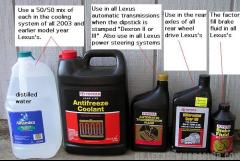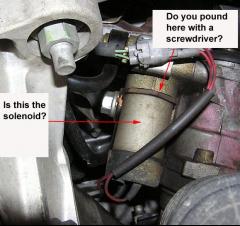-
Posts
1,404 -
Joined
-
Last visited
Content Type
Profiles
Forums
Events
Gallery
Store
Articles
Videos
News & Articles
Everything posted by monarch
-
Why did you change the receiver-drier? Normally the dessicant in a genuine Toyota receiver drier lasts for at least 20 years unless the AC system becomes contaminated with atomospheric moisture due to a severe refrigerant leak or if the system is intentionally discharged of refrigerant in order to change a part or seal. Personally I would use only a genuine Toyota receiver-drier and the factory recommended Densoil #8 lubricant rather than risk degrading the reliability and durability of the AC system with auto parts store quality parts, lubes and additives.
-
As bossman said, the Pontiac Vibe and Toyota Matrix both have Toyota engines, transmissions, suspensions and brakes, just like the 1985 Chevy Nova and Toyota Corolla. So the Vibe will almost match a Matrix in reliability and durability. Prior to 1985 I was a GM loyalist, then in 1986 I bought a Chevy Nova. Owning the Nova inadvertently introduced me to Toyota quality. Instead of constant expensive mechanical problems like I had with my prior GM cars, the Chevy Nova was extremely reliable and durable for the 234,000 miles I owned it. Like a fool, I sold the Nova at 234,000 miles because I wrongly believed it would soon "fall apart". Wrong. The new owner drove it to 394,000 miles at which time it was totalled in a traffic accident.
-
The two oxygen sensors ahead of the catalytic converter affect fuel economy. Generally they should be replaced every 75,000 - 150,000 miles to maintain optimum fuel economy depending if you are mostly a city vs. a highway driver. If you use aftermarket sensors then you could get less fuel economy savings and shorter sensor life. Unfortunately the same mechanics who may talk you into replacing the oxygen sensors will also likely talk you into using lower quality aftermarket sensors since they can't buy genuine Toyota sensors any cheaper than you can and therefore can't make as much of a profit compared to aftermarket sensors. I believe lexls.com has a tutorial for replacing the sensors.
-
We need alot more information. Like are you towing with the Overdrive gear locked out like it says to in the owners manual? Are you keeping your speed down to 55 MPH or less? Is this cooling system filled with a 50/50 mix of genuine Toyota Longlife antifreeze & distilled water? If the cooling system has been filled with aftermarket antifreeze and or tap water for several years (auto service shops tend to use tap water) then you probably need a new radiator like Thi said due to mineral buildups. Is the weight of the boat and trailer combined 3500 lbs or less? What procedure have you been using to measure the transmission fluid level?
-
If the brake pedal sinks to within an inch or so of the floor then whomever last worked on the brakes might have gotten some air bubbles in the brake fluid. The solution is to bleed the brake fluid as described in the factory manual. The factory manual also give the spec for the proper brake pedal height. This all assumes you have factory pads and rotors. If they are aftermarket, then the factory manual can't necessarily be used to diagnoise aftermarket brake wierdness. Toyota brake master cylinders last at least 20 years so the chances of one being bad are extremely remote.
-
The main thing is to lower your expectations - don't expect factory original levels of reliability / durability and functional refinement unless you use genuine Toyota replacement parts. Personally, I'd use Beck/Arnley parts because they at least tend to be made-in-Japan parts.
-
One thing owners take for granted is the fact the factory original Freon R12 AC system was troublefree for 15 years and would still be capable of being largely troublefree for another 15 years if factory approved parts and procedures are used when something minor goes wrong like a freon R12 leak in your case. However, since most owners turn to an independent repair shop when something minor goes wrong, they get talked into modifying (shops call mods an "upgrade") their system (R12 to R134a conversion in your case) using unfactory approved parts and procedures (independent repair shops almost never used factory approved parts and procedures). This is turn sets into motion a chain of seemingly never ending AC system problems and can contributes to the owner's ultimate decision to sell / junk their 15 - 20 year old Toyota / Lexus. So even if you spend $500, $1000 or $1500 at the independent repair shop, don't expect it to be the end of your AC system problems. The shops know this too and that's why their repairs are guaranteed for only 1 year. So in answer to your original question, it is NOT normal for a Lexus to need seriously expensive AC system repairs after 15 years, just minor repairs like replacment of an O-ring seal or two, and maybe a new compressor magnetic clutch and a new receiver-drier if the system has to be discharged of R12 in order to replace a seal. On the other hand, it is normal for a Lexus R12 AC system to begin having alot of expensive continuous problems (evaporator & condenser leaks, expansion valve failure, compressor failure, etc) if the initial minor problems mentioned above are performed by independent general automotive repair shop. The point of my post is to point out alot of the reliability / durability potential of a Toyota AC system goes down the drain thanks to independent shops. Then owners wrongly conclude the Toyota AC system was weakly designed when in fact it was the owner him/herself who deserves the blame for authorizing independent shops to butcher up the engineering of the factory original system. Do-it-yourself owners can also degrade the factory original system if they use auto parts store recharge kits, auto parts store refrigeration oils and auto parts store 0-ring seals. By "degrade" I mean you can only expect the AC system to work a relatively short time using auto parts store stuff - certainly not anywhere near 15 years as the factory original quality stuff could last.
-
If you want to save $$$ then buy in Los Angeles. Check out Longo Lexus and Lexus of Westminster. They even have internet sales reps who will email you quotes.
-
There are two ways of dealing with that issue. 1. Choose an ebay seller that will accept a signed statement that you are purchasing the R12 for resale to certified technician Example of such a seller: http://cgi.ebay.com/ebaymotors/ws/eBayISAP...&category=46094 Seller wrote: "Note that you must provide certification of EPA training as a technician or a signed statement that this refrigerant is being purchased for resale to such a party before this transaction can be completed." Here's another ad that doesn't sound like the seller has strict certification requirements: http://cgi.ebay.com/ebaymotors/ws/eBayISAP...&category=46094 In the highly unlikely event you cannot find an ebay seller that will accept a signed statement, then for just $15 you can take the little 25 question test online (or via mail) to become certified: http://www.macsw.org/macs.asp?mfurl=certify.html I always found ebay sellers who would accept a signed statement. In fact, after the sale nearly all of them didn't even bring up the certification issue and simply shipped the R12 after they got their money! However, since the cost of the certification test was only $15 and the test was so short (25 questions) I decided to take the test anyway out of curiousity. I took it via mail rather than online because that way you can look up the answers to each question as you are taking the test! Yes, amazingly the test is an open book exam so it's impossible to fail!. I learned alot for that $15 and feel it was well worth it (even though I didn't really need the certification to buy the R12 on ebay)
-

Overheating On 93 Es300 - What Not To Do...
monarch replied to poneyboy's topic in 92 - 06 Lexus ES250/300/330
Here's what happens to a Toyota / Lexus cooling system after 17 years and 241,000 miles if the owner simply drains and refills the radiator every year or two with the factory original coolant mixture: http://i5.photobucket.com/albums/y189/mastertech/89rad.jpg http://i5.photobucket.com/albums/y189/mastertech/89hous.jpg http://i5.photobucket.com/albums/y189/mast...h/89drained.jpg -

Overheating On 93 Es300 - What Not To Do...
monarch replied to poneyboy's topic in 92 - 06 Lexus ES250/300/330
Virtually all the overheating problems can be traced to owner refusal to keep the cooling system in factory original condition. Specifically: 1. Owners refuse to use only a 50/50 mix of Toyota Long Life Coolant and distilled water in the system. This prevent radiator leaks from cropping up and eliminates internal radiator clogging. Also greatly slows deterioration of the radiator hoses / heater hoses / radiator cap / thermostat / water pump / cylinder head gaskets. 2. Owners refuse to use a genuine Toyota radiator cap / thermostat / thermostat gasket / water pump / hoses / at replacement time. Why do owners refuse to maintain the cooling system in factory original condition? Answer: They don't seem to appreciate the fact they own an ASIAN car and need to respect and follow the car care advice of the ASIAN car factory engineers (instead of American mechanics, American auto parts stores and American car care websites) if they want to realize the legendary http://www.saber.net/~monarch/463.jpg reliability and durability potential built into every Toyota. So they end up butchering up their cooling systems by using (or letting their mechanics use) non Toyota sourced parts, fluids and repair procedures. I would imagine the same problem may occur in Japan. In other words the (obviously few) car owners in Japan who purchase a Ford or Chevy might fail to appreciate the fact they own an AMERICAN car and need to respect and follow the car care advice of the AMERICAN car factory engineers (instead of Japanese mechanics, Japanese auto parts stores and Japanese car care websites) -
Recharging your '92 with the old Freon R12 is dirt cheap and takes only 5 minutes http://www.saber.net/~monarch/acrecharge.jpg if you fully understand the procedure (pix shows an LS400, but the ES300 is very similar). Basically it's like adding air to a tire using one of those aerosol type tire inflators some people keep in the trunk for flat tire emergencies. Ebay always has tons of cheap ($15-20 a can) genuine R12 available and always will. It's especially cheap during the winter ($10 a can). You system capacity is about 2 - 2 1/2 cans, but to get it to blow cold air again you might only need 1 can. So you have to a decision to make. Either succumb to the overwhelming $dollar$ driven peer pressure / AC industry pressure to convert your system to a Freon R12 substitute or to R134a or learn how simple and cheap it is to keep on using genuine Freon R12 and reap the benefits of superb cooling performance and superior system reliability / durability. If you decide the latter, remember you're on your own since no one connected with the auto repair or AC repair industry will want to teach you how simple and cheap it is to keep on using genuine Freon R12 (since they all make their living pushing conversions and making even more money on all the mechanical problems that crop up after a conversion is made).
-
Transmission behavior can be affected by the tune up condition of the car. So if it were my car I'd first be sure clean, unworn Denso spark plugs are installed bearing the exact same Denso part# listed in the owners manual. Then I'd also clean the throttle plate of accumulated carbon and other goo. Next I'd make sure the transmission was filled with clean, red Dexron III auto trans fluid and I precisely measure the fluid level to make sure it isn't under or overfilled. If the shifting wierdness persisted, I'd suspect at least one of the electronic shift control solenoids requires replacement (it's fairly routine for these to need replacing at roughly between 150-250K miles)
-
Your owners manual says gasoline containing up to 10% ethanol can be used as well as gasoline containing no alcohol or MTBE. So you're OK using either fuel. As SRK pointed out, oxygenates like 10% ethanol reduce emissions which means your emission system components say cleaner, longer, which in turn helps maintain optimum engine power and drivability. The reason the pump says "for boats,collectables, small engines, etc. ONLY" is because the government regulators want the owners who own cars that can use oxygenated gasoline to use it to reduce air pollution.
-

Hello - Back Pressure And Performance? Help!
monarch replied to BlexusGS's topic in 93 - 05 Lexus GS300 / GS400 / GS430
Aftermarket exhausts are for Sound and Show so that's why owners like this one http://www.saber.net/~monarch/boy.jpg don't consider them a waste. -
So far my Autozone alternator (a Denso alternator rebuilt by Bosch) has survived 3,000 miles with the cover installed. I installed the alternator cover to protect myself against becoming stranded until I have time to fix the power steering pump leak.
-
http://www.lexls.com/tutorials/ for the jzz30 ps tutorial. I personally think radiator removal is essential to gain working room to replace the alternator. Use a 6 point 14mm socket to obtain a good grip on the top and bottom alternator mounting bolts http://www.saber.net/~monarch/alt.JPG. If your power steering pump is leaking fluid, you can make a protective cover for the alternator out of an empty 1 gallon bottle of Chlorox http://www.saber.net/~monarch/alternatorcov.jpg
-
In my experience the temp needle stays on the 2nd notch, or just a sliver above the 2nd notch on all 1st generation LS400's equipped with a factory original 180 degree F thermostat and thermostat gasket. Since waf102's temp gauge stays between the 1st and 2nd notches his car might be equipped with an aftermarket 160 or 170 degree thermostat or the thermostat may be stuck open. If it takes the temp gauge along time (more than 3 miles from a cold start) to reach the area between the 1st and 2nd notches, that would be another clue the thermostat is stuck open.
-

Are These Oil Filters Worth Using?
monarch replied to SnesleyWipes's topic in 92 - 06 Lexus ES250/300/330
In the USA, the lowest online price ($3.90 each) for the Denso 90915-YZZD1 filter (it's the latest Denso filter for all ES / RX300 / 330 models) can be found at 1sttoyotaparts.com 1-888-271-3948. You can also buy the Lexus V8 filters (90915-YZZD3) for $3.90 at 1sttoyotaparts.com. Any other genuine Toyota part is similarly discounted 28% off Toyota dealer retail prices (but 1sttoyotaparts.com will not ship fluids / lubes due to Hazmat shipping complications) -
Here's the other side of the coin: 1. http://www.rlb.50megs.com/oiladitives.html Consumer Reports attempted to reproduce the "no oil" test where all the oil was drained out of an engine which had been treated with ProLong, and then the engine was run. CR managed a maximum of 13 seconds running out of each of two engine before they seized up, welding the pistons to the barrels. 2. http://www.chris-longhurst.com/carbibles/additives.html "The Car & Driver magazine engines treated with DuraLube lasted a staggering 11 seconds without oil." 3. I personally accidentally idled my 1986 Corolla engine for 10 seconds without oil (forgot to reinstall the oil pan drain plug before refilling the engine with new oil). The camshaft lobes and rocker arm pads were scratched and scored from that incident of running 10 seconds without oil.
-
Because the valve appears to go bad after roughly 10-15 years causing power steering fluid to be sucked into the intake manifold. See this thread http://us.lexusownersclub.com/forums/index...opic=6583&st=15 I got my valve, Toyota part no. 17630-16040 via mail order from Bob Bridge Toyota in Renton, WA for about $62-63.00 (888)-271-3948, (425)-917-2472, but WA state residents must pay sales tax and the $63 price is only for phone order / internet customers, not walk up counter sales. I havn't installed my air control valve yet, but I've heard the Reseal Kit you have contain the gasket to use on the new air control valve (where it screws onto the ps pump). jadecuir and the planet soarer website both recommend pulling the mainshaft bearing, ao you can replace the seal and o-rings that may leak
-
Congrats! I am facing this job myself and have quite a few questions if you don't mind. Did you use the jzz30 or the planet soarer tutorial or the factory manual as a guide? Was it tricky to bleed the system of air after finishing the installation? Did you change the air control valve that is attached to the PS pump? Did you change the "main shaft bearing" that's mentioned in the planetsoarer tutorial? http://planetsoarer.com/Power%20steering%20pump.htm Did you end up using all the seals in the Toyota Reseal Kit or were some left over? Thanks alot for any help along these lines.
-
RX in NC, to my knowledge, no AWD RX300 member of the LOC or Club Lexus forums has ever stated they have inspected / changed the transmission / differential fluid every 15,000 miles since the day the vehicle was new. And to my knowledge, no forum member / transmission shop / Lexus mechanic has ever told us about a particular part in the tranmssion that is prone to wear rapdily / fail even if the transmission is always fed clean, undeteriorated fluid. Thus, unless new information is forthcoming, I believe it is reasonable to assume the AWD RX300 transmission is capable of lasting over 250,000 miles just like all other Toyota / Lexus automatics if always fed clean, undeteriorated fluid and if not driven in a abusive, frequent lead foot type manner.





